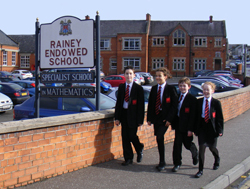Data everywhere
Back then, different bits of information were stored in filing cabinets dotted about the school. Sharing information such as students’ assessment grades meant either photocopying the relevant pieces of paper or sending them by email. Our management information system (MIS) was solely used by our administrative team for logging morning and afternoon attendance.
In my previous role, I had seen first-hand the benefits of introducing technology across the school. Upon my arrival six years ago, I instinctively knew that a similar move could have a positive impact on staff, students and parents.
Information in a few clicks
I began by introducing a monitoring system for lessons. Previously, teachers were recording details about their students in an Excel spreadsheet and pasting the information into a separate document. If there had been a behaviour incident in a particular lesson, the teacher of the following class had to rely on their colleague finding the time to send an email with details of what had occurred and who was involved.
By enabling teachers to enter all this information directly into our MIS during the lesson, it is instantly available to teaching staff across the school as well as the senior leadership team and year heads. This also allows us to create a bank of information about an individual student which is updated on their journey through the school.
No more excuses
I then turned my attention to improving the way we were recording assessment information. Heads of department had been recording test data in an Excel spreadsheet or in their staff planners. Now all the data is stored in one place in our MIS so members of the senior leadership team can see all assessment data with a few clicks.
As the process of logging details of students’ attendance and behaviour had been widely adopted across the school, we knew that asking teachers to input assessment grades by simply right clicking on a student’s record would not be too much extra work.
We now ask staff to record brief statements such as ‘no homework’, or ‘left the room’ against a student’s electronic record. This enables us to track seemingly minor bits of information about a particular student. A teacher could note that a particular student has claimed to have lost a test paper or worksheet, for example. Other teachers may find this information useful. It ensures a teacher can step in and address a particular problem a student might have with organising their school work. It also allows us to build up a pattern of behaviour which we can share at the next parents’ evening.
Lasting impact
Allowing every member of staff to access our MIS and broadening the amount of information held in one central location has made a real difference. Interventions now take place much quicker. We are able to distribute confidential information about students with special educational needs, for example, to individual teachers authorised to see it. They no longer have to solely rely on remembering to raise the issue at a staff meeting. Attendance has improved too as we can closely monitor the attendance pattern of each individual sixth form student and take action to reduce the number of unexpected days they are away from the classroom. It has even had an impact on simple tasks such as finding a parent’s contact number, which no longer involves a call to the school office.
So what’s next? Well, I am keen to further improve communication between the school, students and parents. I feel it is important that we increase the number of reports we provide. Sending reports electronically will allow parents to access information about their child’s learning progress at home or at work using their laptop, tablet or smartphone. Within the next 12 months, we also plan to allow students to access information about their past achievements and their improvement targets.
Introducing small but significant changes to many day-to-day procedures has had an incredibly positive impact across the school. Allowing the student information held on our MIS to be accessed more widely is key to helping us maintain a high standard of teaching and learning for students as they continue their journey on to higher education.


















